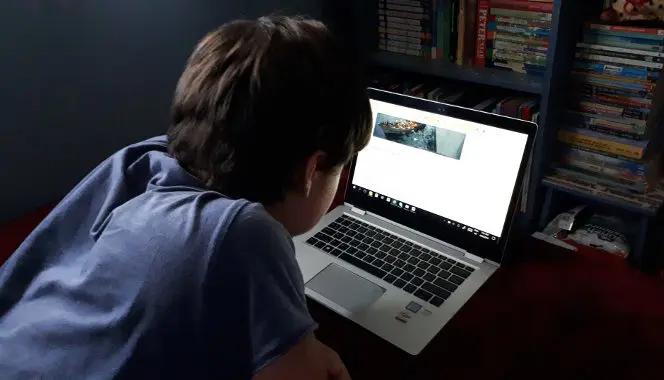How well do your students learn when they read online? What are the outcomes of on-screen reading compared with reading in print?
Implications from current research
Current research suggests that reading online results in lower understanding and less critical reflection. What might this mean for our students’ learning and for society?

I read differently online but what about our students?
I spend a lot of time in front of my laptop reading for research. But when I’m reading for pleasure, I usually grab a print book.
I’ve noticed that my reading is quite different when I’m online. I skim the text quickly, looking for keywords that might relate to what I’m researching rather than settling in for a long read. I often print online articles so that I can read them in hard copy because I find that easier to concentrate on.
For our students who are growing up in a digital world with all its advantages and distractions, I wondered what reading practices have developed to deal with the online world and what their consequences might be.
Online and connected
The online world is vast and there is no sign of data creation slowing down. Our digital experience is enhanced by media-rich content and quick links to other sites, offering convenience, flexibility of approach, and often cheaper costs than print materials. We have instant knowledge of world events and everyone’s reaction to them and can, in turn, instantly react and contribute ourselves.
But not all of this information is unbiased or even relevant to our needs, and the speed at which events are reported gives us little time to evaluate sources, think critically or engage in considered reflection. As Susan Greenfield, a neuroscientist from Oxford University, comments in her 2014 interview with ABC’s Gary Rivett:
The issue is that information isn’t knowledge. Of course, you can be bombarded with endless information, endless facts but if you can’t make sense of them, one fact is the same as any other fact. You can cruise on YouTube or on Google going ‘yuck’ and ‘wow’, but you’re not actually making sense of things.
Digital content — finding, evaluating, using and creating it
Adapting to a fast-paced world
In 2018, journalist Sally Blundell interviewed neuroscientist Maryanne Wolf for The New Zealand Listener. As Blundell and Wolf note:
‘By and large, reading on a screen encourages multitasking, a different form of attention, a different speed of processing’. And if people are skim, skim, skimming, she tells the Listener, ‘and not going deeper to understand the complexity of issues, they will be far more attracted to false news or worse’. There is concern, she says, that digital media and the sheer volume of online information and communication invite the fast and shallow read. The result, she writes, is more and more young people not reading other than what is required, ‘and often not even that: “tl; dr” (too long; didn’t read)’. (2018, October)
Researcher Ziming Liu also notes that:
…screen‐based reading behavior is characterized by more time spent on browsing and scanning, keyword spotting, one‐time reading, non‐linear reading, and reading more selectively, while less time is spent on in‐depth reading, concentrated reading and decreasing sustained attention.
The issues are more compelling for even younger students as their adaptation to a fast-paced digital world may be changing their brains and influencing their ability to develop these skills. The very plasticity of our brain — the ability to respond and adapt to our environment and its challenges — that has kept our species alive for millennia also encourages it to take on the characteristics of whatever medium it is reading on.
If you have a young brain with the evolutionary mandate … to adapt to the environment, and the brain is placed in an environment that is very fast-paced, requiring a little attention span where you move onto the next thing … the brain will obligingly adapt to that. And then you put that same child in an environment where it has to concentrate for a long period of time it won’t have rehearsed that skill. Therefore it won’t be very good at it.
— Susan Greenfield, Technology and the Human Mind (YouTube video, 23:23), TEDxOxford
So, do our digital reading practices foster the reflection and deep reading necessary to evaluate and respond thoughtfully to so much data and information?
Comparing print and digital reading
In Naomi Baron’s 2017 article, Reading in a digital age, her review of related research included a 2011 study by Ackerman and Goldsmith. This study noted that when students have a choice, they spent less time on digital reading, and had lower comprehension scores. Schugar et al (2011) found that participants reading on-screen used fewer study strategies such as note-taking. Baron’s article also cited more recent research by Kaufman and Flanagan (2016) that found that students reading digitally did well on answering concrete questions. However, those reading in print did better on abstract questions needing inferential reasoning.
In Baron’s own research between 2013 and 2015 of more than 400 university students from five countries, 86% preferred reading longer texts in print and 78% when reading for pleasure, with 92% saying it was easiest to concentrate when reading print. 85% of the US students were more likely to multitask in an online environment and only 26% when reading print.
New Zealand researchers Hooper and Herath (2014), in their study Is Google making us stupid? The impact of the internet on reading behaviour, determined that the impact of the online environment on university students’ reading included:
- increased amount of reading due to the growth of online material
- improved speed of reading
- improved skimming ability.
The impact also included:
- change in patience as readers
- multitasking
- distraction
- eye strain
- scanning rather than reading through (in print 82% of participants read from beginning to end).
Reich, Yau and Warschauer (2016), in their report on using tablet-based eBooks with very young children (0–2 years), commented that enhanced eBooks with sounds, animations, and games can distract children and reduce learning. When book-sharing with an adult, conversations during eBook reading are often about the platform while print book conversations are more often about the book content.
Careful design can make a difference
Interestingly, these same researchers have also found that with eBooks that are carefully designed to support reading rather than distract with features that are simply entertainment, the children’s comprehension of a story was at a similar level.
Additionally, eBooks and digital technology can be very engaging for reluctant readers. The National Literacy Trust’s 2015 study of children’s access to eBooks found that:
…boys’ reading levels increased by an average of 8.4 months, compared to 7.2 months’ progress made by girls. Furthermore, the percentage of boys that felt reading was difficult almost halved from 28.0% to 15.9%, suggesting that confidence in their own reading ability increased as a result of the project. In addition, the percentage that felt reading was cool rose from 34.4% to 66.5%.
A recent literature review (2021) of 14 studies on the effect of ebooks on children’s reading by López-Escribano, Montesino, and García-Ortega, notes that ‘when e-books are properly selected and used, children develop literacy skills equally well and sometimes better than with print books’. The authors also noted that:
…children living in a deprived context, at risk of learning disabilities, and English Language Learners benefited from all the reviewed e-book interventions, which highly improved their literacy skills, regarding concepts about print, phonological awareness, vocabulary, and reading comprehension. Digital learning and e-book reading represent a potential compensatory strategy for these children.
Best of both worlds
Both print and online reading are thoroughly established in our students’ daily lives.
Online reading has evolved to allow the quick perusal of a lot of information very quickly — a great strategy for scanning through email for example.
In Baron’s article about her 2013–2015 research, she reports that participants:
…praised digital reading on a number of counts, including the ability to read in the dark, ease of finding material (‘plenty of quick information’) saving paper and even the fact they could multitask while reading.
She also reports that the students in her study commented that print was aesthetically more enjoyable (‘I like the smell of paper’) and that print gave them a sense of where they were in the book — they could see and feel where they were in the text.
Students in Scholastics’ 2012 Kids & Family Reading Report say that eBooks are better than print books when they do not want their friends to know what they are reading, and when they are out and about travelling. Print is better for sharing with friends and reading at bedtime.
Wolf, in her The New Zealand Listener 2018 interview, noted that print reading allows us to slow down and give time to sophisticated deep reading processes, letting us discern truth, apply critical analysis, gauge inference, develop empathy, appreciate beauty to reach the knowledge and wisdom necessary to sustain a good society.
So it’s not an either/or choice
Instead, it’s a matter of how we get the best out of both print and on-screen. Wolf, in her 2018 RadioNZ interview, suggests that we need to teach our students which medium best suits the purpose for which we are reading. Her best hope for our reading future is the ‘bi-literate’ brain — one that uses the optimal skills of each reading style so that students can read deeply as well online as in print.
Find out more
Engaging teens with reading — find inspiration and strategies to encourage teens to read for pleasure.
2019 Research: Reading in a Digital Age — by Read NZ Te Pou Muramura.
Reader Come Home: The Reading Brain in a Digital World — 2018 book by Maryanne Wolf.
Reading on paper versus screens: What’s the difference? – July 2020 article by Kerry Benson.
Skim reading is the new normal — Maryanne Wolf (2018) in the Guardian.
What works better for retention — printed or digital texts? May 2021 article by Naomi Baron.
Reference
Blundell, S. (2018, October). Dear Reader. The New Zealand Listener 85(4088) 13–19 October 2018.





